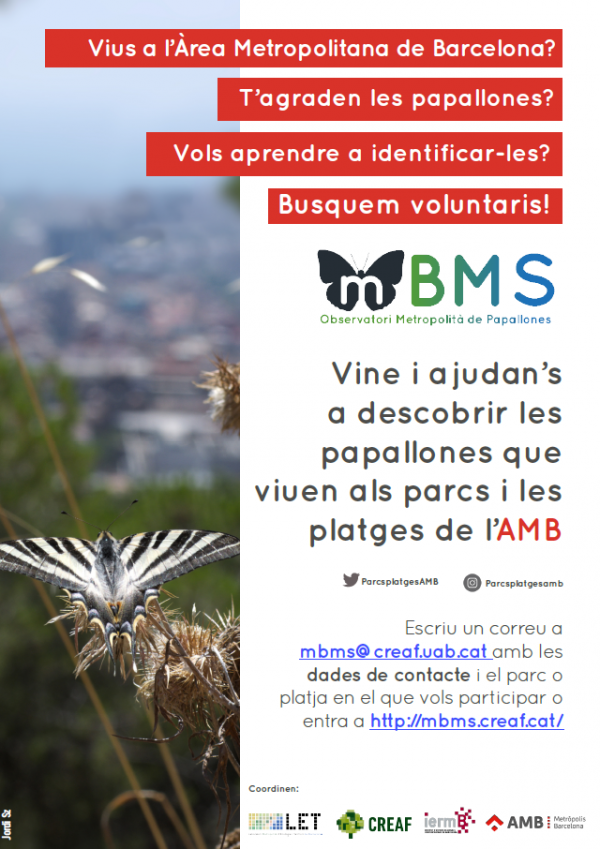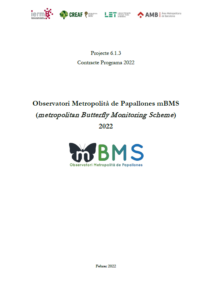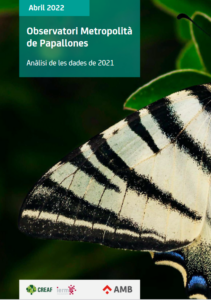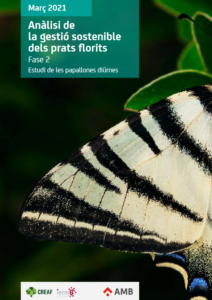BUTTERFLY OBSERVATORY
The new paradigm of global conservation demands a management of biodiversity beyond the limited protection of endangered species and protected areas. There is a consensus about the potential of the metropolis as a refuge for native biodiversity, as well as the importance of a new urban design approach that fosters the presence of this biodiversity. Therefore, it is proposed to transform the metropolis into viable ecosystems for our species. However, knowledge about metropolitan biodiversity is still limited. Butterflies are one of the best biodiversity indicators. Given the growing interest of citizens to participate in environmental projects, LET proposes to create a network of volunteers to identify existing butterflies in three urban parks, three periurban parks and two beaches in the metropolitan area of Barcelona. Thus, relevant data will be obtained to evaluate the biodiversity in our metropolis involving the citizens on their value. With this aim is created the Metropolitan Butterflies Observatory mBMS. In the map you can see the parks and beaches that are being incorporated to the project and the buterfly species that we are all discovering. For more information, you can visit the project website o please contact to this e-mail adress: letbcn@uab.cat.
This new citizen science initiative aims to know the biodiversity of the urban parks and beaches network of the metropolitan area. For this, we decided to study the diversity of butterflies, a very sensitive insect that gives a lot of information to be able to value and improve the biodiversity of different habitats, also of the metropolitan ones. The initiative is impeded by the LET, the Metropolitan Laboratory of Ecology and Territory of Barcelona formed by the IERMB, the CREAF and the AMB.
The first and second phases of the Observatory were launched in six parks and two metropolitan beaches (2019-2020). For the third phase (2021), the Observatory was expanded to ten parks and two additional beaches. In the fourth phase (2022), five more parks have been added. And in the fifth phase (2023) four additional parks and one beach have been added, bringinga the toal total to 26 parks and five beaches in the metropolitan parks and beaches network.
Specifically, it began in the Muntanyeta park (Sant Boi de Llobregat), the Fontsanta park (Sant Joan Despí and Esplugues de Llobregat), the Turonet park (Cerdanyola del Vallès), the Pinetons park ( Ripollet), the Torrent de la Font i del Turó de l’Enric park (Badalona), the Tramvia park (Montgat i Tiana), as well as the Castelldefels peach and the Gavà beach.
The third phase will add the Murtra beach (Viladecans), the Remolar beach (El Prat de Llobregat), the Riu park (El Prat de Llobregat), the Calamot park (Gavà), the Torre-roja park (Viladecans), the Pi Gros park (Sant Vicenç dels Horts), the Llacuna park (Montcada i Reixac), the Can Zam park (Santa Coloma de Gramenet), the Castell park (Castelldefels), the Torreblanca park (Sant Feliu de Llobregat, Sant Just Desvern and Sant Joan Despí), the Canal de la Infanta park (Cornellà de Llobregat) and the Bosc de Can Gorgs park (Barberà del Vallès).
The fourth (2022) phase incorporates the Costeta park (Begues), the Ermita del Pla de Sant Joan park (La Palma de Cervelló), the Can Lluc park (Santa Coloma de Cervelló), the Can Rigal park (Barcelona) and the Bastida park (Santa Coloma de Gramanet).
This year are incorporated the Can Buxeres park (L’Hospitalet de Llobregat), the Ermita park (Castellbisbal), the Nou park (El Prat de Llobregat), the Solana park (Sant Andreu de la Barca) and Sant Adrià beach (Sant Adrià del Besòs).
The Metropolitan Butterflies Observatory mBMS has three main goals:
- To know the biodiversity of the network of parks and metropolitan beaches, using as a object of study the diurnal butterflies, an insect that provides a lot of information to be able to value and improve the biodiversity of different habitats, also of the metropolitan ones.
- Evaluate the results of the management of the biodiversity in the parks and metropolitan beaches.
- Study the diversity of butterflies in the Mediterranean dry meadows, an environment especially rich in biodiversity.
The Observatory is part of the Improvement of the parks and beaches biodiversity Plan. This metropolitan spaces are usually in a intermediate position between the metropolitan urban area and the big natrual spaces. In spite of they are big unknown areas, they welcome much biodiversity and they have a great socioenvironmental value. They can also have a principal role in the ecological connectivity of the territory, since they allow the entrance of wild native fauna to cities. Thus, the study wants to follow the buterflies of these metropolitan spaces and at the same time become a laboratory to test strategies to improve the abundance and diversity of this group of insects.
Volunteers make a field visit every fifteen days from March until October to one or more selected parks in the metropolitan area of Barcelona during which they identify and count the species of butterflies they observe. Becoming a volunteer is not difficult. You do not need to be an expert to identify the species of butterflies present in your city, but you must want to learn and have some free time. When you register you have the option to select the parks or beaches that interest you most. We will try to assign the selected parks or beaches, unless they are already registered by other volunteers; in which case we will contact you to propose alternatives. On the mBMS website you can see everything that you need to participate in the project.

2022
 |
The Metropolitan Butterflies Observatory mBMS. Analysis of the results of 2021. .
See the results report in PDF (linguistic review pending). See the informative summary in PDF. |
2021
 |
The Metropolitan Butterflies Observatory mBMS. Analysis of the results of 2022. .
See the results report in PDF. See the informative summary in PDF. |
2020
 |
Analysis of the sustainable management of flowering meadows. Study of diurnal butterflies. Phase II.
See the results report in PDF. See the informative summary in PDF. |
2019
 |
Analysis of the sustainable management of flowering meadows. Study of the diurnal butterflies. Phase I.
See the results report in PDF. See the informative summary in PDF. |
